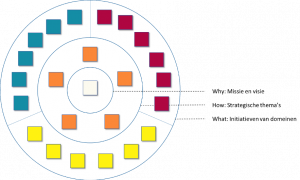Managing value with portfolio management – Part 2
Organizations with multiple development forms share a common goal: realizing value. Portfolio management enables the highest value by continuously managing this in a coherent manner. This follow-up provides a set of handles.

Set a change ambition for portfolio management
First, determine why portfolio management should be implemented or strengthened. Communicate this too! Build support from the start. Common reasons include not meeting customer expectations quickly enough, difficulty making choices, lack of coherence or unsustainable total costs. The change ambition must be strong enough that people are prepared to adapt current behavior. It is recommended to make the change ambition measurable, such as shorter decision-making and development time, higher customer satisfaction, or lower total costs. The goal is a change ambition that—regardless of development form—is recognized at a strategic level and in realization.
Establish strategic themes for portfolio initiatives
A portfolio is guided by strategic themes: inspiring, value-enhancing and concisely formulated spearheads. Strategic themes are often drawn up annually, but are not always properly translated at every level and made measurable. For portfolio management it is important to make them measurable. A common methodology for this is OGSM. This makes it possible to manage portfolio initiatives: continuously select, prioritize and measurably test their contribution to the results (value).
Bring coherence with a portfolio canvas
The portfolio canvas makes it visible in one overview which initiatives contribute to which strategic themes. This provides a lot of control and makes discussions about coherence and added value possible and accessible. The canvas also indicates which part of the organization, hereafter called domain, takes up which initiatives.
Simplified example of a Portfolio Canvas:

The well-known 'golden circle' Why - How - What by Simon Sinek is used to visualize initiatives from domains on the portfolio canvas, as in the example above. Each initiative receives a card with a brief description and the extent to which the initiative contributes to which strategic themes. Team collaboration is promoted by sharing this portfolio canvas with everyone in a central location (see 'obeya').
Collect current and new initiatives
It is regularly important to gain a good overview of all current and intended initiatives. There are all kinds of decision makers, initiatives in different phases, the status of which is not always known and various 'pots' for initiatives. When retrieving initiatives, they can be labeled differently, for example epic, feature or project. It is important to synchronize these concepts so that you can compare apples with apples
Distribute the change budget on an ongoing basis
Traditionally, budget allocation has often been a difficult task. To which domains do we allocate how much budget, will we not exceed the budget and how do we know that the budget has been well spent? This becomes less complex if the principle of lean budgeting is applied at portfolio level. A fixed amount is allocated to domains, after which initiatives are prioritized. This amount is substantiated by a plan and underlying initiatives with (if known) a business case. The principle of lean budgeting prevents budget overruns and continuously allocates budget to the initiatives that deliver the highest value.
The business case
For agile initiatives, the business case contains just enough information to lead to discussion, further elaboration and, in due course, a go or no go decision about the initiative. The business case focuses on goal, scope, expected value, KPIs and sub-initiatives, with a rough estimate of the effort. For waterfall initiatives, the business case is often described in more detail, as part of a project letter or PID. For both agile and waterfall business cases, it is recommended to also indicate an expected value and KPI as soon as sub-initiatives are concretized. In both cases it then becomes possible to evaluate the value of initiatives in the meantime and to allocate a substantiated budget to the next sub-initiative. Moreover, permanent agile teams are more about allocating (committing) resources than about allocating a budget; after all, a budget has already been allocated, on which resources are prioritized.
Distribute capacity continuously
Capacity management is often also a challenge. Traditionally, staff is assembled per project (people to work), sometimes from different corners of the organization. This makes decision-making about availability complex. Where the organization gradually becomes more agile, there will be more peace and regularity in capacity management. This is where permanent agile teams are created, which are designed for continuous prioritization and smooth delivery of initiatives with the highest value (work to people). These permanent teams also have the advantage that their production capacity can be better estimated. That capacity assessment helps portfolio decision-making to select no more initiatives than are feasible. This means that the expectations between strategic and realization levels are better aligned.
Initial guidance is provided on how an organization with different development forms can continuously strive for the highest value in a coherent manner:
- Ensure a measurable joint change ambition
- Synchronize terminology from agile and waterfall initiatives
- Visualize strategic contribution in a portfolio canvas
- Organize budget and capacity distribution on continuous prioritization of the most valuable initiatives
Tips for portfolio organization, the portfolio process and continuous improvement will follow.
Related insights
